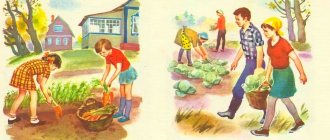What kind of crop is harvested in the fall? Autumn work in the garden at the dacha: harvesting and tillage
The weather in September is still quite warm and allows you to collect the remaining harvest at the dacha. At the beginning of the month, potatoes are dug up, tomatoes, sweet peppers, and eggplants are collected. Then comes the turn of carrots and beets. At the end of the month they begin collecting zucchini, pumpkin and cabbage.
Dig it up in dry weather, otherwise wet tubers will not be stored well. Seed specimens are placed in the sun for several days so that they turn slightly green. Solanine formed in tubers is a toxic substance; it repels rodents, destroys fungal infections and allows you to preserve potatoes until spring. The rest of the harvest is removed immediately to storage rooms, since tubers that have turned green in the sun cannot be eaten.
Tomatoes must be removed from the bushes before the air temperature begins to drop below +5°C. If the fruits have not yet ripened, they are placed in a box, layered with paper towels, and covered with paper. The optimal air temperature for storage is 15 - 18°C.
A sign of ripening carrots is the yellowing of the tops and the appearance of hairs on the root crop. Only whole specimens are suitable for storage, so vegetables should be removed from the ground with caution. The tops are cut off immediately. Root vegetables are not washed, but only ventilated. For storage they are placed in boxes with sand or sawdust.
The best time to harvest beets is the second half of September. By this time, the root crops reach the desired size and accumulate a sufficient amount of useful substances, and the tops begin to fade. Vegetables without damage are selected for storage. The tops are not cut off completely, leaving about 1 cm. It is best to store beets together with potatoes.
To determine whether cabbage is ready for harvesting, you need to squeeze the head of cabbage. If it is elastic and does not press through, you can cut it off. The upper leaves are removed, leaving a stalk of approximately 2-3 cm. Small, dense heads of cabbage of light color are stored well.
After harvesting, the area is cleared of tops. It should be borne in mind that the tops of potatoes, tomatoes, cucumbers, peppers and eggplants are destroyed immediately. It cannot be used to further fertilize the soil in the form of compost. Closer to autumn, many leaves are affected by a disease such as late blight, and the ground may become contaminated.
Caring for our little brothers
The homes of animals that spend the winter outside human homes also require special attention. These include cows, horses, sheep, goats, rabbits, chinchillas, ferrets, minks, poultry and bees.
The work of a person living in a rural area in the fall is very different from the activities of a city dweller. After all, the villager needs to caulk the cracks in the barn, in the poultry house, insulate the cages intended for small animals or bring them into indoor spaces, move the hives with bees to the omshanik.
And the most caring owners do not even forget to hang a piece of thick fabric or a rubber mat at the entrance to the doghouse and check whether it is comfortable for the animal to go inside and whether it understands how to do it.
Taking care of our smaller brothers, that is, the living creatures inhabiting the planet, is an important and necessary work of man in the fall. At school, children make bird feeders, hang them up, and in winter make sure there is always food for the birds in them.
The work of people in the field. Educational project “People’s work in nature in spring”
Maria Yatsenko Educational project “People’s work in nature in spring”
Topic of the week: “People’s work in nature in spring”
Goal: To form initial ideas about the spring work of people in nature.
Getting to know the profession of a gardener, observing the work of a janitor.
Observing the planting of seeds of flowering plants and vegetables in the beds.
Create a desire to help adults.
Foster respect for the work of adults.
Conditioning: Kitten toy
Album about professions
Interaction with parents and society: organizing a cleanup day together with parents.
Final event: “Subbotnik”
Direct educational activities Joint organized educational activities
• Cognition
Topic: "People's work"
(Green milk p. 106)
• Design/application
Topic: “Birdhouse” (Komarov page 76)
Teach children to depict objects consisting of several parts in appliqué. Improve your knowledge of colors. Develop color perception.
• Communication:
Topic: “Examining the painting “People in the Garden”. Sound culture of speech: sound s, z” (Gerbov p. 75)
Practice clear pronunciation of sounds with Exercise children in the ability to conduct a dialogue.
• FEMP
Topic: “Left, Right” (L. G. Peterson, E. E. Kochemasova Playing game p. 80)
To consolidate the ability to understand and use the words “left”, “right”, “in the middle” in speech, to form an idea of the position of an object to the right and left of oneself.
Artistic creativity:
- Drawing
Topic: “Shovel and rake”
(Koldina p. 43)
Teach children to draw objects consisting of a combination of lines; draw objects large, placing images over the entire surface of the sheet.
— Modeling
Topic: "Trolley"
(lesson notes)
Physical development
Topic: Lesson 15
Goal: to teach different ways of walking.
Train in alternating running, walking, and formation at the instructor’s command.
Develop motor activity and observation skills.
What do they do in the fall? 30 things to do in the fall
Many of us find it difficult to cope with the passing summer heat. However, we often forget how pleasant and romantic autumn can be if we take advantage of its gifts.
1. For the last time this year, organize a barbecue with friends or family outdoors.
2. Make a wreath of fall maple leaves.
3. Organize a photo shoot against the backdrop of colorful nature.
4. Spend the evening in front of the fireplace with a cup of hot chocolate.
5. Buy yourself new gloves, a scarf or a comfortable sweater. Buy yourself at least something new and beautiful.
6. Prepare charlotte according to a new recipe. Or an old favorite recipe.
7. Sit on the windowsill watching the rain.
8. Plan a day off to watch your favorite movies and do nothing on that day.
9. Find your favorite warm pajamas.
10. Prepare the pumpkin. Even if you don't like it, you should definitely cook pumpkin at least once in the fall.
11. Bicycles in the autumn park.
12. Choose mushrooms.
13. Lie down on the rustling leaves, looking up at the sky.
14. Cuddle your cat every night.
15. Blow bubbles from the balcony and admire them in the sun.
16. Breathe cold air in the morning.
17. Buy clothes for next summer at a discount. And then put it away and take warm and comfortable clothes.
18. Find a new type of tea and take it with you in a thermos to work, treat your colleagues.
19. Re-read your favorite book.
21. Visit your parents with a cake or cookies you made.
22. Have time to visit an amusement park and sit by the fountain.
23. Organize a general cleaning in your home, in your thoughts, in your soul.
25. Light candles in the evening.
26. Post wishes of happiness and a warm autumn printed on leaflets to your neighbors at their doors.
27. Install new wallpapers on your computers and gadgets.
28. Decorate your windows with wreaths of fall leaves, acorns, chestnuts and pine cones.
29. Make a pumpkin monster for Halloween.



